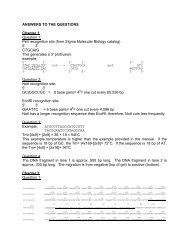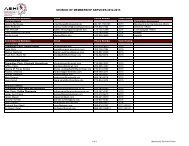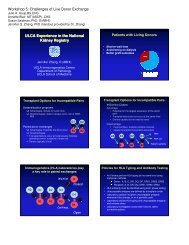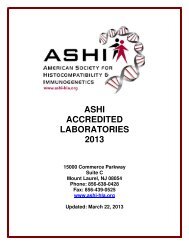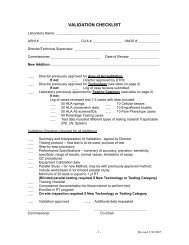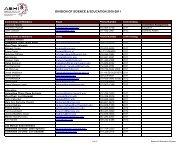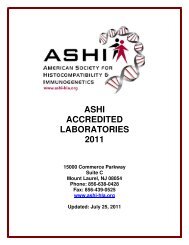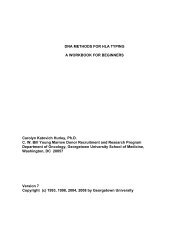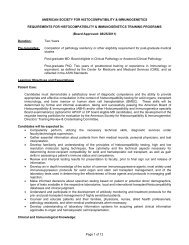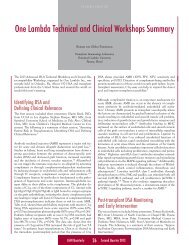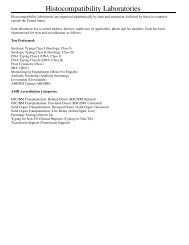Monday, September 27, 2010 2:00 PM - American Society for ...
Monday, September 27, 2010 2:00 PM - American Society for ...
Monday, September 27, 2010 2:00 PM - American Society for ...
- No tags were found...
You also want an ePaper? Increase the reach of your titles
YUMPU automatically turns print PDFs into web optimized ePapers that Google loves.
Tadafumi Asaoka 1 , Shigeru Marubashi 3 , Tomoaki Kato 4 , Seigo Nishida 2 , Panagiotis Tryphonopoulos 2 ,Akin Tekin 2 , Edie Island 2 , Jang Moon 2 , David Levi 2 , Gennaro Selvaggi 2 , Ichiro Takemasa 3 , HiroakiNagano 3 , Yuichiro Doki 3 , Masaki Mori 3 , Andreas Tzakis 2 , Phillip Ruiz 1 . 1 Transplant Laboratories,University of Miami Miller School of Medicine, Miami, FL, USA; 2 Surgery, University of Miami, Miami,FL, USA; 3 Surgery, Osaka University, Suita, Osaka, Japan; 4 Surgery, Columbia University MedicalCenter, New York, NY, USA.Aim: Despite recent advances in immunosuppressive therapy, acute cellular rejection (ACR) remains amajor challenge in liver transplantation. However, there are no specific biomarkers available to monitor thealloimmune response. We hypothesized that certain mRNAs provide critical regulation of an ensuingintragraft immune effector response. The aim of the present study was to identify molecular biomarkers <strong>for</strong>ACR in liver allografts.Methods: We examined 21 liver biopsy samples consisted of Acute Cellular Rejection (AR: 10 cases, allgrade 2 or 3), Indeterminate ACR (IND: 7 cases, all grade 0) and Recurrent Hepatitis C (CHC: 4 cases,inflammatory grade 2 or 3) obtained from recipients after liver transplantation. RNA was isolated from the<strong>for</strong>malin-fixed paraffin-embedded (FFPE) biopsy samples and transcribed to cDNA. We utilized a PCRbased TaqMan Low Density Custom Array containing 96 assays <strong>for</strong> candidate transcriptomes selectedbased on our previous study (Differential transcriptome patterns <strong>for</strong> acute cellular rejection in recipientswith recurrent hepatitis C after liver transplantation. Liver Transpl 2<strong>00</strong>9;15(12):1738-49). Relativequantification was done based on pooled normal liver using a comparative Ct method.Results: We successfully detected more than 80% of candidate transcriptomes using FFPE liver biopsysamples. We could simultaneously follow up selected candidate transcriptomes.Conclusions: It is sure that we need the large sample set to evaluate the utility of our custom plate anddetect the cut off values and predictive values of key molecules. But our method could potentially serve asnew appropriate diagnostic tool to monitor the rejection status.74-PCRITICAL ROLE FOR HOST T CELLS IN MIXED ANTIBODY MEDIATED REJECTION OFRENAL ALLOGRAFTS.Alice A. Bickerstaff Gaughan, Jiao-Jing Wang, Ronald P. Pelletier, Nicholas DiPaola, Patrick Adams,Sergey Brodsky, Tibor Nadasdy, Gregg A. Hadley. The Ohio State University.Aim: We have developed a mouse model of renal allograft rejection that mimics the common clinicalscenario of mixed cellular and antibody mediated rejection (mixed AMR) in sensitized recipients. The goalof the present study was to evaluate the role of T cells in promoting graft injury in this model.Methods: Mice were primed by donor skin rejection and then transplanted with renal allografts. To test therole of T cells in this model, primed recipients were treated with anti-CD8 and anti-CD4 mAbs on POD -3,-2, and -1. To test the role of donor-reactive antibodies and T cells, each were adoptively transferred intoimmunodeficient recipients of renal allografts.Results: Primed recipients acutely rejected renal allografts (mean survival = 8.6 ± 4.3 days) with allserologic and histologic features of mixed AMR. FACS analysis of graft infiltrating T cells revealed a vastpredominance of CD8 T cells. Surprisingly, CD8 T cell depletion did not prevent acute graft loss whereasCD4 T cell depletion prevented features of mixed AMR including elimination of donor-reactivealloantibodies from the serum long-term (>130 days). Analysis of long-term functioning grafts revealedgrafts void of PTC complement deposition but with evidence of chronic injury and an accumulation ofCD8+CD103+ cells. In transfer studies, anti-donor sera and MHC class I mAbs did not promote detectablerenal allograft injury in immunodeficient mice; in contrast, primed T cells were highly effective at elicitingfunctional graft destruction.Conclusions: These data are consistent with a critical role <strong>for</strong> host CD4 T cells as effectors that promoteacute destruction of renal allografts and thus challenge current dogma that anti-donor alloantibodies are thesole mechanism of graft injury during mixed AMR. These data further suggest a distinct mechanism <strong>for</strong>chronic rejection of renal allografts with CD8 T cells playing a key role.



